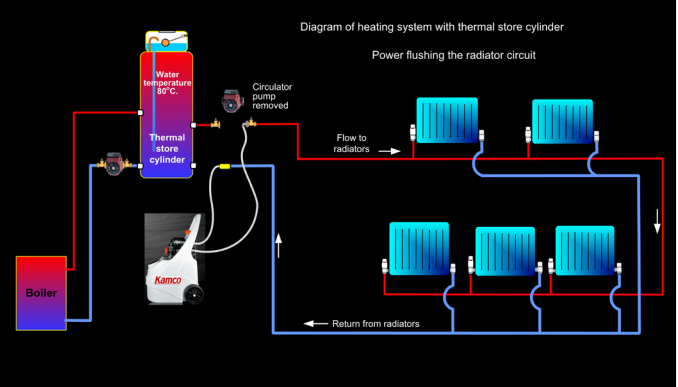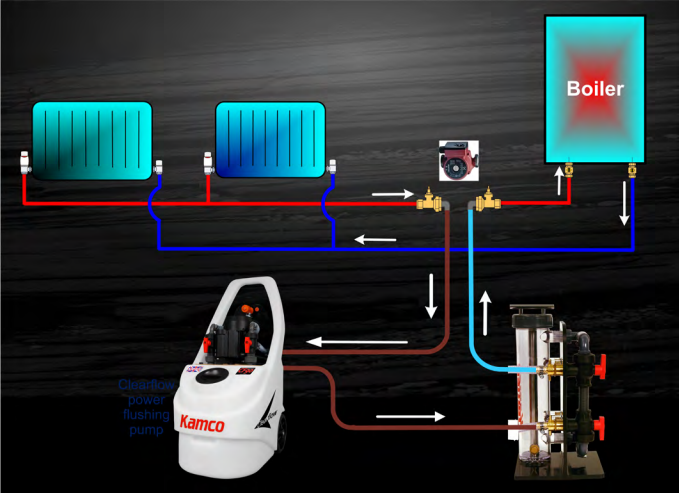Power flushing of central heating system

General questions:
Q. How long does it take to power flush a system thoroughly?
A. It will vary from house to house, but generally about 5+ hours for a three bed house with a vented system, but less time for a sealed / combination boiler system, because you don’t have to cap off the cold feed and expansion piping. You can save more time by using also by filtering the water as you go with a CombiMag power flush filter.
Q. How big a heating system can you use a Clearflow pump on?
A. CF90 Classic, can tackle systems up to 40 radiators with the right technique.
On larger systems CF90 Quantum2 will get more debris from any given system (even a small microbore one!)
Q. Will power flushing cure boiler noises?
A. Boiler noises are often caused by scale or debris accumulating on heat transfer surfaces, thus preventing the water from carrying away heat from the metal surface. This means that the metal runs hotter than design temperature and may even exceed 100 degrees C. The layer of scale / debris is never even, and there will be areas where the water contacts metal above 100 degrees. At this temperature water flashes into steam, increasing its volume by almost 1500 times. The steam bubbles then move away from the high temperature zone and collapse and it is the sound of the implosion of the steam bubble that you hear. This phenomenon is most likely to occur when the boiler first fires and is working hard.
It is a reasonable assumption that if you can remove the debris / scale (and you usually can when power flushing) that you will remove the problem. Having said that, we know that boilers with cast iron heat exchangers can acquire corrosion pits as they age, generally if the water treatment has been inadequate. In these areas, where the heat exchanger metal is reduced in thickness, the heat flux can be higher than the designer intended, and there can still be boiler noises no matter how clean the heat transfer surface may be after a power flush.
Q. Can you power flush a heating system with a thermal store type cylinder?
A. Yes. Our advice is to isolate the thermal store cylinder and flush the radiator and boiler circuits separately.
There are two reasons for this:
Q. How often should I check the corrosion inhibitor level, and how do I do it?
A. The annual checking of inhibitor level is an excellent idea – you have to know what brand inhibitor is IN
the system. There is currently no test kit that will test for the presence of all inhibitors. The only safe thing is to drain down and start again if the brand inhibitor in a system is unknown.
There are many different formulations, as most good and proven inhibitors will be a blend of up to a dozen components. It is important that the adhesive sticker supplied with the inhibitor is left attached to the system / boiler so that you know what inhibitor is in the system – and when it was added.

Q. How do I go about flushing underfloor system?
A. The first question we usually ask is “Are you sure the system needs flushing?”, If the whole house has
underfloor heating, with no radiators or towel rails, where might the debris have come from?
Often heating circuits are mixed systems, perhaps with radiators upstairs where it is most difficult to convert to underfloor heating, and with underfloor heating plastic pipework downstairs, and it is corrosion debris from the upstairs radiators that is accumulating in the under floor circuits.
Underfloor circuits usually have a separate circulation pump.
Generally this is organic, bacterial matter which has occurred as a result of degradation of glycol based antifreeze type products in the water. The temperature of underfloor circuits needs to be much
lower than conventional central heating circuits (in order to prevent householders ‘tap dancing’ on very hot floors), and this lower temperature is very conducive to bacterial growth.
Q. If I have an underfloor heating system with bacterial growth, how can I remove it, and prevent future problems?
A. You need a specialist cleaner to break down and remove bacterial matter in heating systems. Kamco
Systemsafe-Bio is the product we use. Circulate it through the heating system for at least 4 hours if using the system circulator pump, or up to 24 hours if the system is heavily fouled. You can reduce this time by 75% if using a power flushing pump.
Q. Is it necessary to bleed radiators after a power flush?
A. Yes. However, the amount of air in the radiators is usually small. If you keep the water level in the Clearflow tank at least 15 cm (6”) above the minimum, you’ll minimise the air to be bled from radiators.
Q. Can you guarantee to get a system clean with a power flush?
A. Although an engineer may power flush a system until the water exiting the dump hose is clear, and will usually carry out tests to check this, it is not uncommon for a system with relatively clear water to still have some compacted debris in the lower parts of the system / radiators. This may later break loose and discolour the water, although it is rare that it is in sufficient quantity to cause problems.
Engineers occasionally find a layer of very hard black iron oxide corrosion debris (magnetite) in the form of scale on the internal surfaces of pipe work, and which has developed over many years. Sometimes this hard scale will not be removed by a power flush, but fortunately the same adhesive nature that makes it difficult to remove also tends to keep it bonded to the pipe where it does no harm.
How long will a power flush last?
Q. Once I have a power flushed a house, will it require flushing again after a few years?
A. We would not expect a well designed system without obvious problems to require a further powerflush in less than five years, and generally for much longer than that if the system has been properly treated with a Buildcert approved inhibitor. However, there are too many variables and unknowns for us to give specific advice.
Q. Is power flushing considered expensive?
A powerflushing is considered expensive primarily because it requires specialized equipment, skilled labour from a qualified heating engineer, and often involves complex procedures to thoroughly clean a central heating system, which can take a significant amount of time depending on the size and complexity of the system, including the number of radiators involved; this all contributes to the higher cost compared to other maintenance tasks.
